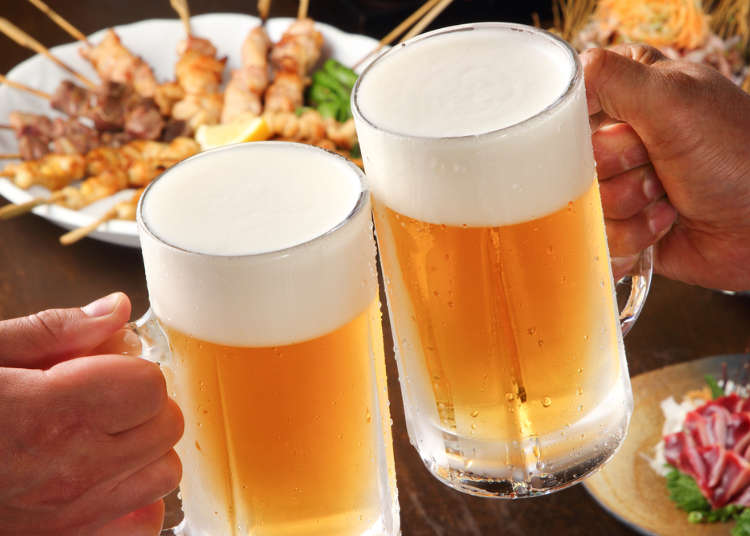
Izakaya are places where you can enjoy casual dining and drinking in Japan. Prices are usually affordable and not only are beer and Japanese sake served, but many types of home-style cooking as well, the menus often loaded with delicious dishes.
Izakaya are especially popular with office workers who crowd them after work to relax and let their hair down before heading back home. But for visitors who are looking to sample a wide variety of Japanese food all in one sitting, they're the perfect place to go!
For first-time visitors to Japan, though, going to an izakaya might seem a bit daunting. In this article we will introduce phrases often used in izakaya from the time you enter the pub until you leave it.
Japanese phrases to remember: Entering an izakaya
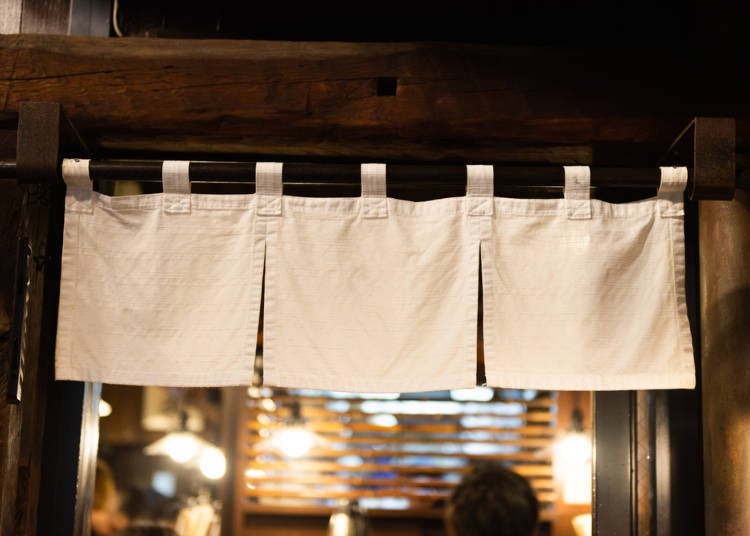
If there are seats available, you can enter an izakaya even if you don’t have a reservation. If you see an izakaya that catches your eye, then duck under the shop curtain and enter it.
● Irasshaimase (いらっしゃいませ) [Welcome]
Everyone is greeted with that expression when they enter pretty much any shop in Japan, but it's especially pronounced in izakaya. Usually the whole staff will say this loudly and enthusiastically. Irasshaimase and yokoso are both words of welcome used when greeting customers as they enter. You will hear them when you enter almost any shop in addition to izakaya, but it can be confusing the first time you hear it! It sounds like they're shouting at you as you walk in, but it's just a heart welcome.
● Nanmei-sama desu ka? (何名様ですか?) [How many of you are there?]
Often you will be asked this when you enter. It means how many are there in your group. If answering hitori desu [just one] is difficult, you can just hold up a finger to show how many of you there are.
Japanese phrases to remember after you are seated in an izakaya
Seating varies from pub to pub, but generally there several types of seating. If you have a preferred type of seating you have seen at an izakaya, you can select a place that offers it.
● Kaunta-seki (カウンター席) [counter seat]

Seating in izakaya can be divided into two main types. Counter seats are designed for one or two customers and offer a view of the cooking area on the other side of the counter. At a counter seat not only can see you observe the food being prepared, but also converse with the cooks.
● Teiburu-seki (テーブル席) [table seat]

Table seating is the style generally found in restaurants and can accommodate anywhere from a small number to a large number of people depending on the size of the table. Sometimes it means being seated with other customers you don’t know.
●Zashiki (座敷) [tatami-mat seating]

Tatami, woven straw mats, is the traditional flooring in Japan and some izakaya have tatami rooms called zashiki in which you must remove your shoes before entering. In some shops the area under the table on the mats is recessed and this arrangement is called horigodatsu. These are more comfortable as rather than having to sit formally on your legs, you can put them in the recessed area under the table.
●Koshitsu (個室) [private room]

Private rooms are set off from the other seating area. These are recommended if you prefer more privacy. If the room is only partially set off, then it is called hankoshitsu [semi-private room].
●Tachinomi (立ち飲み) [standing drinking]

This is a bar that has no or very few seats so you are required to stand. Tachinomi shops generally are cheaper and more relaxed and places you can easily drop by.
Japanese phrases to remember related to items in izakaya
Once you’ve been seated the next thing to do is to order what you would like to eat. But before that, it is useful to know the names of certain items and how to use them.
● Oshibori (おしぼり) [wet towel for your hands]

Once you are seated a staff member will give you a damp towel. This is for wiping your hands, and face if you like, and it can be either warm or cool and also either made from cloth or paper. Another name for this item is otefuki which literally means “hand wipe”.
●Menyu (メニュー) [Menu]

As with any place where you might eat, the menu lists all the drinks and dishes offered. As you can see, the Japanese pronunciation is the same as it is in English. Some establishments also have English menus. To ask if there is an English menu you can say, Eigo no menyu wa arimasu ka? [Do you have an English menu?] Try that.
●Kozara (小皿) [small plate]

This is a small plate or dish. In izakaya food is served in large dishes so the food can be shared. For that reason, most shops have stacks of small dishes on the tables or counters or are brought together with the large dish.
If there are not enough small dishes, you can ask the staff for more by saying, “Kozara o kudasai.” [Please bring more small dishes.
How to order drinks in Japanese: Phrases to remember
Generally at izakaya the first thing you order after sitting down is a drink. Most izakaya have several different types of sake, so here are some useful words for ordering drinks.
●Nama biiru (生ビール) [draft beer]
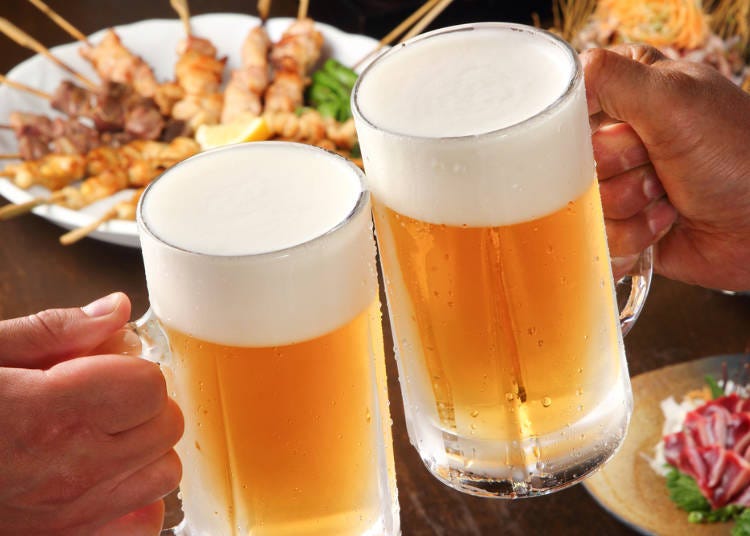
This is the Japanese word for draft beer. Most Japanese usually start off with a glass of beer and generally that means draft beer. The most common way it is served in an izakaya is in a frosty mug.
●Nihonshu (日本酒) [Japanese sake]

Japanese sake is made from fermented rice. Overseas it is generally referred to as Japanese sake. There are many kinds of sake and those unique to a specific region are called jizake [local sake] and are definitely something you should try.
The following expressions can be used to describe how you want the sake served.
___ de onegaishimasu. Please serve it at (temperature).
・冷や (hiya) - At room temperature
・冷酒 (reishu) - Chilled
・熱燗 (atsukan) - Heated to about 50 ~ 55 degrees
●Shochu (焼酎)

Shochu is a liquor distilled from rice, wheat, sweet potato, or buckwheat. The following are expressions that describe the most popular ways of ordering it.
・ストレート (straight) - Straight
・水割り (mizuwari) - Mixed with water
・お湯割り (oyuwari) - Mixed with hot water
・ロックで (rokku de) - On the rocks
Shochu can also be mixed with other things, such as tea or juice, in which case the drink is called chuhai or sawa (sour).
●Nonarukoru (ノンアルコール) [Non-Alcohol]

Non-alcohol drink. This is a drink for people who prefer not to drink alcohol.
How to order food in Japanese: Phrases to remember
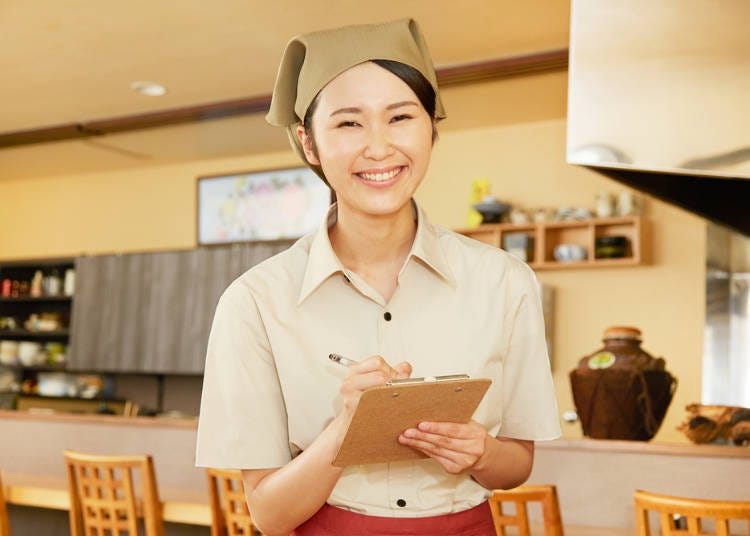
Here are some useful expressions to remember when ordering food from the menu. Many of the dishes are designed to go really well with drinks, so you might enjoy trying several different kinds.
●Chumon o onegaishimasu (注文をお願いします) [May I order?]
Use that phrase when you are ready to order. Usually you can get the attention of a waiter by raising your hand. In some izakaya there are buttons you can push to summon a waiter.
●Osusume wa nan desu ka? (おすすめは何ですか?) [What do you recommend?]
When you are not sure what to order, ask the waiter for a recommendation. Often dishes being recommended for that day are posted or indicated on the menu.
●Kore o onegaishimasu. (これをお願いします) [I would like this.]
When you order you can say that phrase while pointing to the item on the menu. Kore means “this” in Japanese and you can use it in many situations.
The following are a number of standard dishes offered in most izakaya.
●Edamame (枝豆) [green soybeans in the pod]
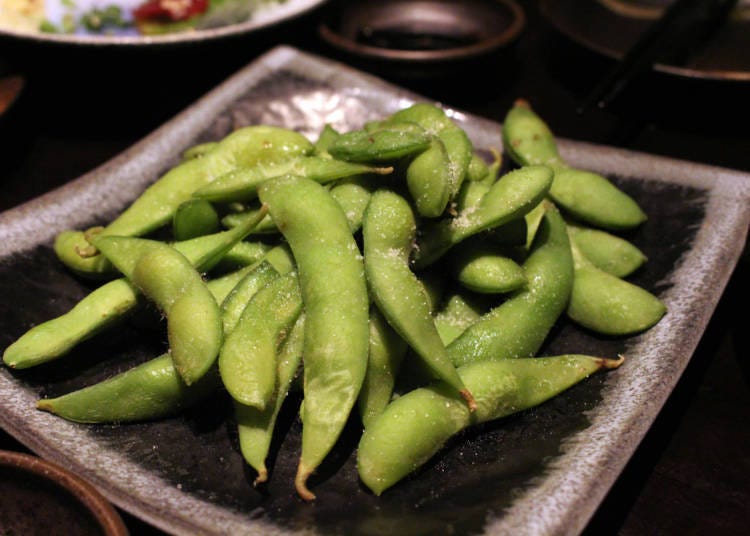
These are soybeans that have been boiled in their pods and salted. They go really well with beer. Recently edamame have become popular overseas and are called by their Japanese name there, too.
●Hiyayakko (冷奴) [cold tofu]

This is cold tofu that is topped with green onion or ginger on top of which soy sauce has been added.
●Karaage (唐揚げ) [fried chicken]
This is bite-sized pieces of chicken thighs that have been seasoned with soy sauce, ginger, and garlic and coated in potato starch before being fried. Essentially it is Japanese-style fried chicken.
●Yakitori (焼き鳥) [grilled chicken skewers]

Bite sized pieces of various chicken parts are skewered and then grilled. The popular way to eat them is either with sauce or salt. Tori refers to chicken. If other kinds of meat are used, such as pork or beef, then such skewers are called kushiyaki.
●Shime (シメ) [last order]

Shime is not the name of a particular dish but refers to the last drink or dish ordered. When it gets close to the end, people often say, "Sorosoro shime o tanumo," [Let's order one more dish and call it a night.] and probably they will select an item from the menu full of carbohydrates such as rice balls, ramen, udon, or a bowl of rice topped with hot tea.
Eat whatever you like! Be sure to check out hodai (放題)[unlimited] systems, too!
![Eat whatever you like! Be sure to check out hodai (放題)[unlimited] systems, too!](https://rimage.gnst.jp/livejapan.com/public/article/detail/a/00/03/a0003257/img/en/a0003257_parts_5cf0fd39888c3.jpg?20200728181547&q=80)
Some pubs have a system whereby if you pay a fixed amount, you can drink as many drinks as you like within a certain time, such as 60 minutes or 90 minutes, called nomihodai, or you can eat as many various dishes within the set time, called tabehodai.
Don't be surprised if you are served a dish you did not order. This is called otoshi (お通し) and is an obligatory appetizer served in lieu of a table charge

When you order a drink you are also served a small side dish. This is called otoshi and is a custom commonly employed in all izakaya. Even though you did not order it, you will be charged for it, so consider it a form of table charge.
There are many useful phrases to remember while you are drinking in an izakaya!

Once you've successfully ordered, all that's left is to just wait for your food and drinks to be served. The atmosphere in izakaya is generally a congenial and friendly one.
●Kanpai! (乾杯) [Cheers!]
Usually people toast one another with the first drink saying, “Kanpai!” which is equivalent to the English “Cheers!” When saying this, all lift their glasses and then take a drink.
●Okawari o kudasai (おかわりをください) [Please give me another one]
When you want to order the same drink or food again, use this expression. It means bring me another order of the same thing.
●Oishii desu (おいしいです) [It's delicious]
When you like the drink or food and say this, it will not only please the staff but may also lead to them recommending other dishes you might like.
Last of all: How to pay your restaurant bill in Japanese

After you have enjoyed yourself in the izakaya it is time to settle the bill. Here are some final expressions for then.
●Gochisosama deshita (ごちそうさまでした) [Thank you for the delicious meal.]
This is a standard expression said at the end of the meal to staff which also indicates to them that you would like to have the check now. Another way to ask for the check is to say Okaikei o onegaishimasu. [Check, please.]
●Warikan (割り勘) [splitting the bill]
If you wish to split the bill among the diners, then use this expression. Keep in mind, however, that usually there is only one bill so you would have to calculate the individual costs yourselves.
●Arigato gozaimashita (ありがとうございました) [Thank you]
When you are leaving the pub invariably the staff will thank you for your patronage by saying those words. Saying that the meal was delicious is a courteous gesture that is much appreciated.
It still is not possible to use English in most izakaya, so knowing a few basic Japanese expressions will enable you to enjoy yourself in one even without using English. The staff and customers in izakaya are truly a friendly bunch, so visiting one will give you another glimpse into Japanese culture and also prove to be a very enjoyable time well spent.
*Prices and options mentioned are subject to change.
*Unless stated otherwise, all prices include tax.
Recommended places for you
-

Did You Say Drinkable Mayonnaise?! 5 Quirky and Fun Drinks to Try in Japan This Winter
-

Experience the Best of Shiga Prefecture at COCOSHIGA! From Japan's Largest Lake Biwa to Tasty Omi Beef
-

40 Winter Sports & Ski Packages To Book in Japan (2024-2025 Season)
by: Himanshi Shah
-

SENSE ISLAND/LAND Art Event in Yokosuka: Discover Unique Performances on the Uninhabited Island of Sarushima
-

Japanese Sake-Brewing Joins UNESCO Intangible Cultural Heritage List
-

The Ride of Your Life! Experiencing Japan from Above in a Private Helicopter Tour
by: Cassandra Lord
Inspiration for Accommodations
-

Top Ranked Hakone Hotels with Mt. Fuji View: Enjoy Stunning Scenery from Your Private Space
-

Convenient Tokyo Hotels with Airport Shuttle: Ideal for Families and Heavy Luggage
-

Stunning Tokyo Tower View Hotels: Enjoy Spectacular Scenery from Your Private Space
-

Family-Friendly Hotels with Free Shuttle to Disneyland: Convenient Access for a Magical Stay
-

Convenient Asakusa Hotels with Kitchens: Ideal for Extended Family Visits
-

Experience Luxury: Hakone's 10 Best Five-Star Accommodations
-

Enjoy Mt. Fuji Autumn Leaves! Top Hotels Near the Popular Autumn Leaves Corridor
-

Experience Hakone Fall Foliage from Your Room with Stunning Views
-

Enjoy Mt. Fuji from the Comfort of Your Room! Recommended Ryokan with Mt. Fuji View
-

Experience Luxury at Mt. Fuji Resort Hotels! Best Extended Stay Options for Families
-

Kuramae Guide: Discovering Arts, Crafts, and the Spirit of Tokyo’s Old Downtown
-

JR Edition: Visit all of Tokyo in one Day with the Tokyo Metropolitan District Pass!
-

What to Pack for Japan: 8 Essential Things for a Hassle-Free Trip
-

Inside Nezu Art Museum: Authentic Japanese Garden in the Heart of Tokyo, an Oasis of Omotesando
-

The CASIO S100: How CASIO's Masterpiece Calculator Redefines Business Elegance With Japan-Made Reliability
-

Complete Guide to Buying Japanese Medicine in Japan: Phrases and Vocabulary You Need to Know
- #best ramen tokyo
- #what to buy in ameyoko
- #what to bring to japan
- #new years in tokyo
- #best izakaya shinjuku
- #things to do tokyo
- #japanese nail trends
- #what to do in odaiba
- #onsen tattoo friendly tokyo
- #daiso
- #best sushi ginza
- #japanese convenience store snacks
- #best yakiniku shibuya
- #japanese fashion culture
- #best japanese soft drinks




















